The Snow Boots For Women Market is estimated to be valued at USD 930.1 million in 2025 and is projected to reach USD 1262.2 million by 2035, registering a compound annual growth rate (CAGR) of 3.1% over the forecast period.
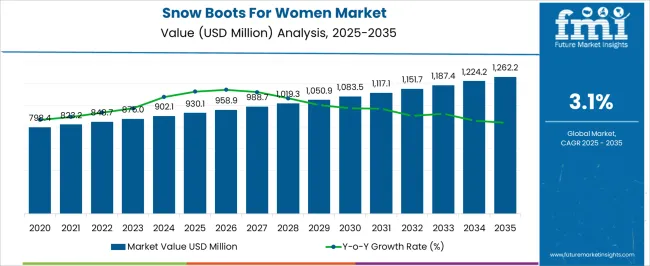
| Metric | Value |
|---|---|
| Snow Boots For Women Market Estimated Value in (2025 E) | USD 930.1 million |
| Snow Boots For Women Market Forecast Value in (2035 F) | USD 1262.2 million |
| Forecast CAGR (2025 to 2035) | 3.1% |
The snow boots for women market is experiencing steady growth, driven by increasing winter travel, fashion-forward winterwear trends, and expanding participation in outdoor recreational activities. Rising consumer demand for insulated and weatherproof footwear with aesthetic appeal has pushed brands to innovate in terms of design, weight, traction, and thermal performance. Retailers are capitalizing on e-commerce platforms and social media to target diverse demographics, while premium brands are launching product lines focused on performance and style.
Urban snowfall, along with prolonged cold weather in many regions, has amplified day-to-day demand for snow boots beyond recreational use. Sustainability and animal-free materials have also influenced consumer preferences, prompting the use of alternatives to traditional leather and fur.
Continuous investment in lightweight insulation, slip-resistant outsoles, and water-resistant uppers is expected to sustain product differentiation and category expansion. With seasonal demand patterns becoming more consistent and brand portfolios diversifying, long-term market resilience is anticipated across both fashion and utility segments.
The market is segmented by Product Type, Material Type, End Use, Price, and Sales Channel and region. By Product Type, the market is divided into Outdoor Snow Boot and Sports Snow Boot. In terms of Material Type, the market is classified into Synthetic, Rubber, Leather, Shearling, and Other Material Type. Based on End Use, the market is segmented into Residential and Commercial. By Price, the market is divided into Economic and Premium. By Sales Channel, the market is segmented into Sport Stores, Specialty Stores, Multi-Brand Stores, Independent Small Retailers, Online Retailers, and Other Sales Channels. Regionally, the market is classified into North America, Latin America, Western Europe, Eastern Europe, Balkan & Baltic Countries, Russia & Belarus, Central Asia, East Asia, South Asia & Pacific, and the Middle East & Africa.
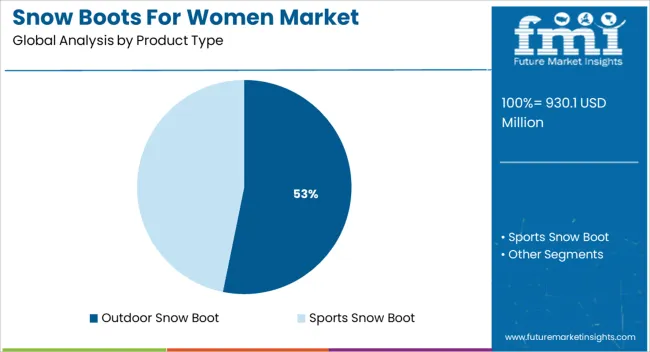
Outdoor snow boots are expected to hold a leading 53.2% revenue share within the product type segment in 2025. This dominance is attributed to the functional advantages they offer, including enhanced insulation, waterproofing, and rugged outsoles designed for extreme winter conditions. These boots are particularly favored in regions with heavy snowfall and colder climates, where protection and performance are prioritized.
Their durability and versatility have made them suitable not only for outdoor recreation such as hiking and snowshoeing but also for daily winter commuting. Increased marketing of outdoor lifestyles and health-oriented cold weather activities has further contributed to their demand.
Brands have focused on integrating lightweight materials and thermal linings to ensure comfort while maintaining weather protection. This balance of functionality and comfort has firmly established outdoor snow boots as the most preferred option in the women's snow footwear category.
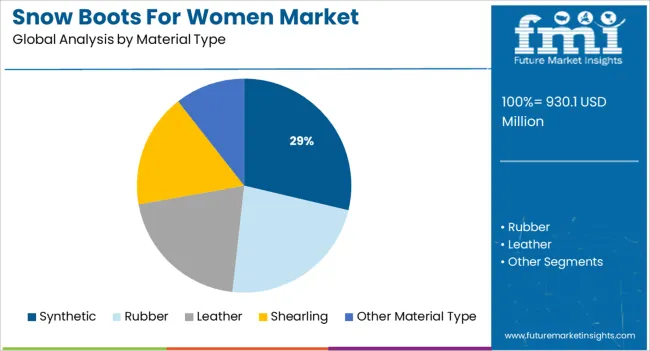
The synthetic material segment is projected to account for 28.7% of revenue in 2025 under the material type category. This segment's strong performance is supported by its affordability, wide availability, and ease of fabrication into water-resistant and flexible upper constructions.
Synthetic materials have become the preferred choice for mid-range and entry-level snow boots due to their capacity to mimic the appearance and texture of premium materials while remaining cost-effective. The material's lightweight nature and moisture-repelling characteristics have proven effective in providing insulation and comfort.
Additionally, the growing preference for vegan and cruelty-free fashion has accelerated the demand for synthetic alternatives to leather and animal-derived linings. Ongoing innovation in breathable synthetics and recycled materials has positioned this segment for continued growth among eco-conscious consumers and brands seeking scalable, sustainable solutions.
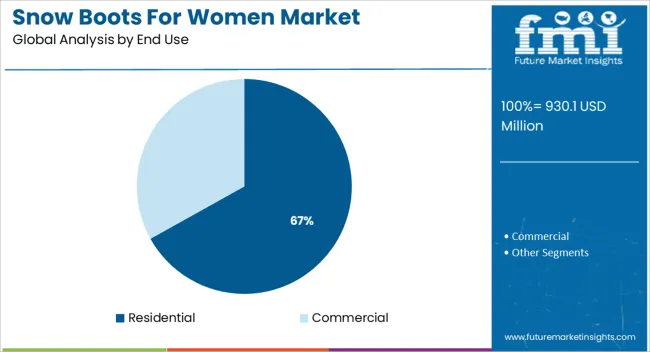
The residential end use segment is anticipated to dominate the market with a 66.9% revenue share in 2025. This is primarily due to the increasing use of snow boots for routine winter wear, especially in suburban and urban settings where snowfall is frequent. Consumers are increasingly purchasing snow boots not just for outdoor adventures but for everyday tasks such as commuting, shopping, and school runs.
The fusion of fashion and functionality in snow boot designs has made them an essential part of winter wardrobes. Additionally, growth in online retail has improved product accessibility, enabling homeowners and city dwellers to explore a wider variety of styles and performance levels tailored to casual use.
Enhanced comfort, easy-to-wear features such as slip-on designs, and multi-purpose treads have also encouraged frequent use in non-commercial settings. These consumer-driven factors have cemented the residential segment’s position as the largest contributor to the women’s snow boots market.
Global study on Snow boots for women market explains that the market has shifted its course after the advent of covid-19. The snow boots for women market, just like other markets have been affected due to the spread of novel coronavirus, this market also slowed down due to the shutdown of production facilities.
Lack of employment led to a shortage of money and the cash crunch slowed down the demand for snow boots among women. The government implemented bans on travel and logistics, which also affected the market as boots are necessary items for travel purposes.
Though, governments around the world have invested huge capital to revive boot and shoe manufacturing industry. The snow boots for women market is led to surge and recover during the forecast period.
The future of snow boots for the women's market is full of innovative ideas and new additional components. Using better warm fabric like leather and rexine keeps the feet warm. This way, the market dynamic is changing with the latest sole technology integrating with new fabric designs is anticipated to furnish the demand for women's snow boots.
With the government lifting travel and logistics bans, more and more people are going on trips. A good amount of these trips include mountaineering, trekking, and snow skiing trips that demand a good pair of snow boots as it helps you climb/trek faster and saves the feet from any damage or injury.
Expanding winter sports around the globe and women's involvement into the games along with fashion trends and celebrity endorsement are pushing the sales of snow boots for women market while it defines multiple sales and distribution channel for the market.
Snow boots for women market survey defines the growth prospects of the market with the increasing size of snow-based travel and tourism programs along with higher number of water and snow-based games happening around the world in the forecast period.
Sales of snow boots for women are attributed to the quality and deliverance of the show on certain factors like escaping snow capabilities. The new sole technology prevents slipping and stops the moisture from retaining it on the boot’s sole.
The improvement in the design of snow boots to escape snow from entering them and help in walking and running in snowbelt spaces has led to the adoption of snow boots by women living in such areas.
Snow boots for women market report define that covid-19 has already affected the travel & tourism sector while hindering the production and manufacturing units. Apart from this, the higher cost associated with water and snow sports is hampering the sales of snow boots for women.
Lower involvement of women in sports as a career option is slowing down the demand for snow boots for women while governments of these third-world nations run initiatives to spread awareness about equal rights. Environment concerns around leather manufacturing and the emission caused by it limits the production of women snow boots.
Snow boots for Women Market:
| Attributes | Snow boots for Women Market |
|---|---|
| Market Value (2025) | USD 848.2 Million |
| Growth Factor | Higher involvement of women in the snow-based sports along with the government financial support to recovering industries like the footwear and leather industry is furnishing the sales of snow boots for women in different regions. |
| Future Opportunities | Emerging sales and distribution channels along with intense changing climatic conditions and its effects on women are creating opportunities for the market. |
| Market Trends | Craze for outdoor sports activities such as skiing and snowboarding amongst women is gaining traction for the snow boots for women market. |
Tactical Footwear Market:
| Attributes | Tactical Footwear Market |
|---|---|
| CAGR (2025 to 2035) | 4.9% |
| Market Value (2025) | USD 1.84 Billion |
| Growth Factor | Increased number of defense troops and their enhancing gear systems are adding better tactical footwear and other equipment into the battel kit. High capital investment through governments is propelling market growth. |
| Future Opportunities | The opportunities that the market brings are strong material,use of mixed material in the sole of these tactical boots that are majorly used by defense personals. |
| Market Trends | The recovering market is fueled by new technology trends that enhance the boot’s strength in the most extreme environments without any wear and tear. |
Work Boots Market:
| Attributes | Work Boots Market |
|---|---|
| CAGR (2025 to 2035) | 9.2% |
| Market Value (2025) | USD 11.03 Billion |
| Growth Factor | The increased compliance and awareness around the industrial safety gear is fueling the gaining traction for the work boots market while it increases the productivity of the end user industries. |
| Future Opportunities | The opportunities related to the advanced sole technology that integrates with the latest materials used are fueling the demand for work boots while enhancing the boot quality |
| Market Trends | The trend of producing industry-specific boots with helpful components attached are helping the market gain traction and setting up future trends for new material technology. |
By material, rubber type holds the biggest share in the snow boots for women market and is anticipated to hold the same ground by the end of the forecast period. This huge market share is attributed to certain factors like its naturally waterproof properties and its capability of withstanding snow and extremely cold conditions to help protect the feet.
Another factor gaining space for this type of material type is the introduction of neoprene rubber is attracting a higher number of producers towards its qualities and its high adoption by the customers is anticipated to boost the market over the forecast years. Therefore, this fuels the overall sales of snow boots for women.
Snow boots for women market opportunities rise with its outdoor product type in and are forecasted to fuel the sales during the whole forecast period. This growth is owed to its common use in the snowbelts and to the women who work outside.
Normal boots get filled with snow and cold water and can hurt the feet while snow boots for women come with the snow escaping technology and their fabric and fitting keeps the feet warm and safe. Women working in snow can easily suffer from frostbite. Therefore, the use of these outdoor snow boots help women working outdoors in snowbelts.
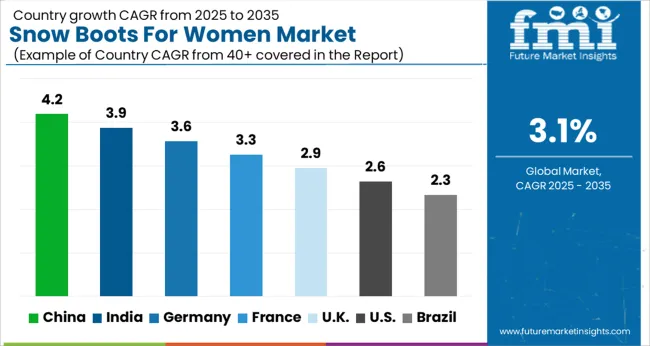
Snow boots for women market demand analysis explain that North America is anticipated to hold a market share of 24.80% in 2025. This significant market share is attributed to the income per capita, increasing craze in ice and snow sports along with a higher number of snow belts that consume most of the snow boots market.
The United States itself consumes the most from the market as it has snowbelt regions like Alaska. Women working outside in these regions adopt these types of boots to keep their feet safe and warm. These factors are expanding Snow boots for women market share.
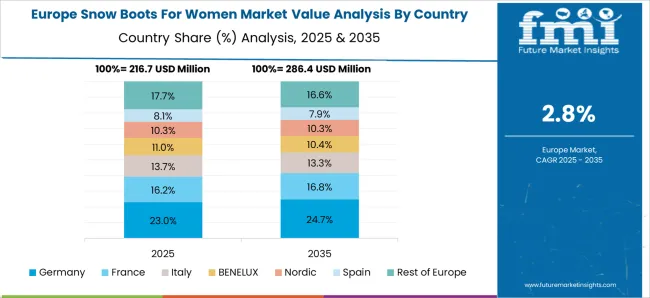
Global market research report on Snow boots for women records the Europe region as the biggest shareholder with the global share of 29.30% in the global market and is likely to hold its position in the is attributed to the governments in Western Europe are investing huge amounts of capital to revive these multiple industries.
Also, Europe is known as a fashion hub with Italy and France being the center of footwear innovations while Western Europe and its Snowbelts demand female snow boots to prevent cold-based diseases like frostbite. Collectively, these factors make Europe the fastest growing region in snow boots for women market.
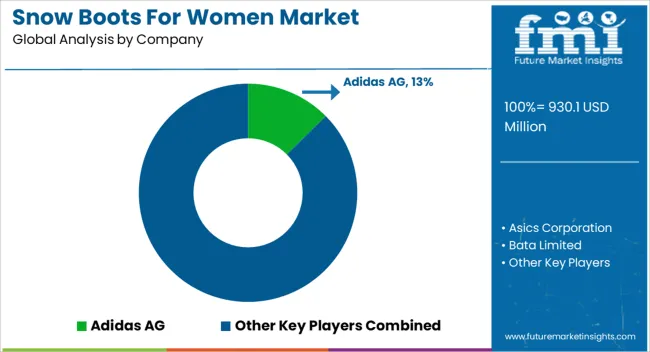
A new market research report on snow boots for women states that as the market recovers from the damage done by covid-19, the market is set to grow and key players are bound to innovate and come up with new ideas to woo the customers. The competitors now focus on the reliability, safety, and comfort of the boots.
Recent Developments
A huge population shifting its bases to higher regions of mountains and hills for better lifestyle is fueling the sales of snow equipment and gear like snow boots. As the covid-19 pushed people to follow work from home measure, many of these people are living on the mountains and working from there.
This scenario has also helped the market revive its space in the global market. Though the largest consumption comes from the rising involvement of women into travel adventures and snow sports. Games like Ice Hockey, Skiing, and Snowboarding are attracting people from all the regions towards them. This enhances the economy as well as they fuels the snow boots for women market’s pace.
The rising tourism led to the high number of health conditions due to the extreme cold, such a condition is known as frostbite.
To understand the condition of the patient, there are several stages that needs to analyzed:
| Attributes | Details |
|---|---|
| CAGR (2025 to 2035) | 3.1% |
| Forecast Period | 2025 to 2035 |
| Historical Data Available for | 2020 to 2024 |
| Market Analysis | USD Billion for Value and Million. Sq. M. for Volume |
| Key Regions Covered | North America; Latin America; Europe; East Asia; South Asia; and the Middle East & Africa |
| Key Countries Covered | USA, Brazil, Mexico, Germany, UK, China, India, Japan, Australia, and GCC Countries |
| Key Segments Covered | Material, Product, Price, Sales Channel and Region |
| Key Companies Profiled | Global Win; Sperry; Greatonu; Sorel; Totes; Arctix; Reebok; Decathlon; Puma |
| Report Coverage | Market Forecast, Company Share Analysis, Competition Intelligence, DROT Analysis, Market Dynamics and Challenges, and Strategic Growth Initiatives |
| Customization & Pricing | Available upon Request |
The global snow boots for women market is estimated to be valued at USD 930.1 million in 2025.
The market size for the snow boots for women market is projected to reach USD 1,262.2 million by 2035.
The snow boots for women market is expected to grow at a 3.1% CAGR between 2025 and 2035.
The key product types in snow boots for women market are outdoor snow boot and sports snow boot.
In terms of material type, synthetic segment to command 28.7% share in the snow boots for women market in 2025.






Full Research Suite comprises of:
Market outlook & trends analysis
Interviews & case studies
Strategic recommendations
Vendor profiles & capabilities analysis
5-year forecasts
8 regions and 60+ country-level data splits
Market segment data splits
12 months of continuous data updates
DELIVERED AS:
PDF EXCEL ONLINE
Snowplow Industry Analysis in North America Size and Share Forecast Outlook 2025 to 2035
Snow Cone and Commercial Shaved Ice Machines Market - Ice-Cold Refreshments 2025 to 2035
Snowmobile Trailer Axle Market
Snow Tyre Market
Snow Pushers Market
Snow Boots Market Analysis - Trends, Growth & Forecast 2025 to 2035
Electric Snowmobile Market Size and Share Forecast Outlook 2025 to 2035
Mountain and Snow Tourism Market Analysis – Trends, Growth & Forecast 2025 to 2035
Rain Boots Market Trends - Growth & Industry Forecast 2025 to 2035
Duck Boots Market Trends - Growth & Industry Outlook 2025 to 2035
Industry Share & Competitive Positioning in Work Boots Market
Wedge Boots Market Growth - Trends & Demand Forecast to 2025 to 2035
Ankle Boots Market Trends - Size, Growth & Forecast 2025 to 2035
Riding Boots Market Analysis - Growth, Demand & Forecast 2025 to 2035
Desert Boots Market Growth - Trends & Demand Forecast 2025 to 2035
Cowboy Boots Market Analysis – Growth, Demand & Forecast 2025 to 2035
Combat Boots Market Analysis – Growth, Demand & Forecast 2025 to 2035
Sneaker Boots Market Insights - Size & Forecast 2025 to 2035
Lace Up Boots Market Trends – Growth & Demand Forecast 2025 to 2035
Hunting Boots Market Growth – Trends & Demand Forecast to 2035

Thank you!
You will receive an email from our Business Development Manager. Please be sure to check your SPAM/JUNK folder too.
Chat With
MaRIA